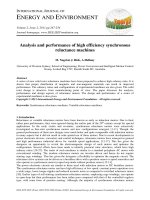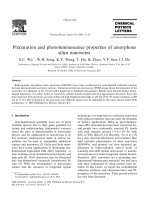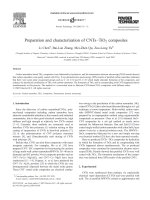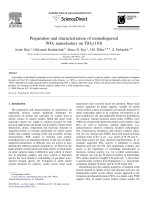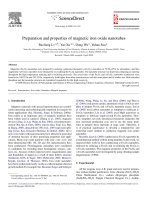- Trang chủ >>
- Khoa Học Tự Nhiên >>
- Vật lý
Preparation and photoluminescence of high density siox nanowires with fe3o4 nanoparticles catalyst
Bạn đang xem bản rút gọn của tài liệu. Xem và tải ngay bản đầy đủ của tài liệu tại đây (757.09 KB, 4 trang )
Preparation and photoluminescence of high density SiOx nanowires with Fe
3
O
4
nanoparticles catalyst
X.J. Wang
a,
⁎
, B. Dong
b
, Z. Zhou
a
a
School of Electronics Engineering and Computer Science, Peking University, Beijing 100871, China
b
School of Science, Dalian Nationalities University, Dalian 116600, China
abstractarticle info
Article history:
Received 6 January 2009
Accepted 29 January 2009
Available online 12 February 2009
PACS:
81.05Y
78.55
Keywords:
SiOx nanowires
Photoluminescence
Large scale, high density SiOx nanowires have been synthesized using a novel Fe
3
O
4
nanoparticles catalyst.
The lengths of SiOx nanowires are in the range of several tens to hundreds of micrometers, and the diameters
of nanowires are 20–80 nm. Transmission electron microscopy and high-resolution transmission electron
microscopy show that the SiOx nanowires are amorphous, and energy dispersive X-ray spectrometry analysis
reveals that SiOx nanowires consist of Si and O elements in an atomic ratio of approximately x=1.4–1.7. The
vapor–liquid–solid (VLS) mechanism is the main formation mechanism of SiOx nanowires. The SiOx
nanowires have two broad photoluminescence peaks at about 405 nm and 465 nm when the 250 nm
ultraviolet fluorescent light excitation is applied at room temperature. The SiOx nanowires with good
photoluminescence properties are promising candidates for ultraviolet–blue optical emitting devices.
© 2009 Elsevier B.V. All rights reserved.
1. Introduction
Since the discovery of carbon nanotubes by Iijima [1], one-
dimensional nanomaterials have stimulated great interest because
of their potential fundamental and practical applications in many
areas such as material research, chemistry, physics and engineering,
etc. Among the one-dimensional nanomaterials, silicon oxide nano-
wires are of great significance in the fields of photoluminescence (PL),
localization of light, near-field optical microscopy, low-dimensional
waveguide, and nano-inter-connection integrated optical devices
[2,3]. Several methods, including chemical vapor deposition [4],
carbon-assisted methods [5], laser ablation [2], and thermal evapora-
tion [6] have been developed to prepare silicon oxide nanowires. Since
the majority of silicon oxide nanowires fabrication methods are
catalyst-based methods, different kinds of catalysts have been used,
such as Au, Pd–Au, Fe, Ga, Ga–In, Ni, In–Ni, Sn, and Co [2,3,7].
Magnetite (Fe
3
O
4
) is a common magnetic iron oxide that has a cubic
inverse spinel structure with oxygen forming a fcc closed packing and
iron cations occupying interstitial tetrahedral sites and octahedral
sites. In the past decades, Fe
3
O
4
is becoming more and more attractive
because of its intrinsic half-metallic ferromagnetic nature, which can
be widely used in catalysts, biological assays, chemical sensors, and
superparamagnets [8,9]. Recently, efforts have been devoted to
preparation of Fe
3
O
4
nanoparticles, nanowires and nanotubes. In
2002, Sun and Zeng [10] prepared the size-controlled monodisperse
Fe
3
O
4
nanoparticles with 4–16 nm by high-temperature solution
phase reaction of iron (III) acetylacetonate (Fe(acac)
3
) in the presence
of alcohol, oleic acid, and oleylamine. The size-controlled mono-
disperse Fe
3
O
4
nanoparticles can be used for a wide range of
disciplines, including magnetic fluids, catalysis, biotechnology/bio-
medicine, magnetic resonance imaging, data storage, and environ-
mental remediation. In the paper, we for the first time prepared the
large scale, high density SiOx nanowires using the novel Fe
3
O
4
nanoparticles as ca talyst. Ph otolumines cence of SiOx nanowires
fabricated by the method was measured, in order to explore the
possibility of application in light emitting devices.
2. Experimental
Fe
3
O
4
nanoparticles with diameter less than 10 nm were
synthesized by high temperature solution phase reaction of iron (III)
acetylacetonate with 1,2-dodecandiol in the presence of oleic acid and
oleylamine. The growth of SiOx nanowires was conducted in a
horizontal tube furnace with a quartz tube. The mixture of Fe
3
O
4
liquid-drops and silicon powders was deposited on Si (111) wafer. The
SiOx nanowires grew by a two-step raising temperature method. In
the first procedure, when the temperature of reaction region reached
400 °C, the sample was transferred to reaction region rapidly and kept
there for 30 min to eliminate the remained oleic acid and oleylamine.
Then, the sample was returned to out of reaction region. Ar gas flow
rate kept up 300 sccm through this p rocedure. In the second
procedure, when the temperature of reaction region was increased
to 1000–1200 °C, the sample was transferred to reaction region
Materials Letters 63 (2009) 1149–115 2
⁎ Corresponding author. Tel.: +86 1062882397.
E-mail address: (X.J. Wang).
0167-577X/$ – see front matter © 2009 Elsevier B.V. All rights reserved.
doi:10.1016/j.matlet.2009.01.084
Contents lists available at ScienceDirect
Materials Letters
journal homepage: www.elsevier.com/locate/matlet
rapidly again. The growth of SiOx nanowires started. The reaction
lasted for 2 h in this procedure under a constant 50 sccm flow rate of
Ar gas. After the furnace was cooled to room temperature, the white
product was found on the surface of Si(111) substrate. Field-emission
scanning electron microscope (FESEM) (XL-SFEG, FEI Corp.) with
energy-dispersive X-ray spectroscopy (EDS) was used for morpholo-
gical observation and element composition analysis of SiOx nano-
wires. X-ray diffraction (XRD) (D/Max-2400, Rigaku Corp.) with
CuKα radiation was assumed for phase structure of Fe
3
O
4
nanopar-
ticles. Transmission electron microscopy (TEM) (Tecnai-20, PHILIPS
Corp.) and high-resolution transmission electron microscopy
(HRTEM) (Tecnai F20, FEI Corp.) with electron energy loss spectro-
meter (EELS) were employed to perform the microanalysis of SiOx
nanowires. Photoluminescence measurement was performed at a
fluorescence spectrometer (F4500, HITACHI corp.) with a resolution of
1.0 nm.
3. Results and discussion
Fig. 1(a) shows TEM image of Fe
3
O
4
nanoparticles. It can be seen
that the monodisperse Fe
3
O
4
nanoparticles with diameter about 8 nm
were observed from the TEM image. X-ray diffraction is used to obtain
structure information of Fe
3
O
4
nanoparticles, as shown in Fig. 1(b). It
indicated the highly crystalline cubic spinel structure was detected
from the XRD pattern. The reflection peak positions and relative
Fig. 1. (a) TEM image of Fe
3
O
4
nanoparticles, (b) XRD pattern of Fe
3
O
4
nanoparticles.
Fig. 2. SEM images and EDS of SiOx nanowires deposited on the Si(111) substrate at the reaction temperature of 1000 °C for 2 h. (a) and (b), The lower magnification SEM images of
the nanowires, (c) The higher magnification SEM image of nanowire tops, (d) EDS of the nanowires.
115 0 X.J. Wang et al. / Materials Letters 63 (2009) 1149–115 2
intensities of Fe
3
O
4
nanoparticles agree well with standard Fe
3
O
4
XRD
card (JCPDS No. 85-1436).
Fig. 2(a)–(c) shows the SEM images of SiOx nanowires deposited
on the Si(111) substrate at the reaction temperature of 1000 °C for 2 h.
Large scale, high density nanowires are uniformly covered on the
surface of Si(111) substrate, as illustrated in Fig. 2(a) and (b). The
lengths of these nanowires are in the range of several tens to hundreds
of micrometers. Fig. 2(c) shows the higher magnification SEM image
of nanowire tops. It can be clearly seen that, at every one top of these
nanowires, there is a droplet whose diameter is much larger than that
of related nanowire. Similar products were also observed at reaction
temperatures of 1100 and 1200 °C. The composition analysis of the
products was achieved using EDS. Fig. 2(d) shows EDS spectrum of the
nanowires, indicating that the products only consist of silicon and
oxygen elements. Quantitative analysis shows that the atomic ratio of
Si:O is 1:(1.4–1.7), suggesting that the SiO
1.4–1.7
nanowires have been
synthesized by the method. The EDS measurement achieved on the
nanowire top displays the existence of a small amount of elemental
iron. Further sample characterization was carried out using transmis-
sion electron microscopy and high-resolution transmission electron
microscopy. Fig. 3(a) shows the low magnification TEM images of SiOx
nanowires. The diameters of SiOx nanowires are in the range of 20–
80 nm. The global droplets on nanowire tops were not observed
because the gl obal droplets have no strong connection with
nanowires, and separated from related nanowires when these
nanowires were ultrasonically dispersed in ethanol. Fig. 3(b) shows
the HRTEM images of the nanowire. No crystal structure was
observed. Electron diffraction was done to determine its structure,
as shown in the inset of Fig. 3(b), suggested that the nanowire is
amorphous. Chemical composition of the nanowire was analyzed by
electron energy loss spectroscopy. Si and O peaks were observed, and
no iron, carbon and other impurities could be detected, revealing that
the nanowire is pure SiOx nanowire, which is consistent with result of
EDS spectrum.
The vapor–liquid–solid (VLS), solid–liquid–solid (SLS), and oxide-
assisted (OA) growth mechanisms have been used to explain the
growth of silicon nanowires and silicon oxide nanowires. In our
experiments, Fe
3
O
4
nan oparticles are employed as catalysts to
fabricate SiOx nanowires. We have also tried to synthesize SiOx
nanowires without Fe
3
O
4
catalysts, but no one-dimensional SiOx
nanomaterials were found on t he surface of Si(111) substrate.
Moreover, EDS also detected the existence of iron only at the top of
SiOx nanowires. The fact suggested that the Fe
3
O
4
catalysts play a key
role in the formation of SiOx nanowires, and a VLS mechanism is the
most probable growth mechanism. Here, we give a description for the
possible formation of SiOx nanowires. Firstly, with the temperature
increased from 400 °C to 1000 °C, Si vapor is generated at high
temperature by the vaporization of silicon powder. Meanwhile, Fe–Si–
O nanoclusters form on the surface of Si(111) substrate, which act as
nuclei for the formation of SiOx nanowires. As the droplets become
supersaturated, amorphous silicon nanomires are formed by the
reaction between Si and O. Oxygen source may come from two factors,
one is the oxygen in Fe
3
O
4
nanoparticles, the other is the remainder
oxygen in the reaction chamber. The presence of a small amount of O
is not expected to change the Fe–Si phase diagram significantly, but in
the meanwhile it acts as the oxygen source during the silicon oxide
growth.
Fig. 4 shows the room-temperature PL spectrum of SiOx nanowires
under the 250 nm ultraviolet fluorescent light excitation. Two broad
PL emission peaks are clearly observed at the center wavelengths of
about 405 nm (3.06 eV) and 465 nm (2.67 eV). The PL properties of
various silica nanowires have been studied extensively [2]. It has been
suggested that the 2.7 eV band is attributed to the neutral oxygen
vacancy (≡Si–Si≡), while the 3.0 eV band corresponds to some
intrinsic diamagnetic defect center, such as twofold coordinated
silicon lone-pair centers (O–Si–O). Therefore, we believe that the PL
emissions from the SiOx nanowires should be attributed to the above-
mentioned defect centers, which arise from the oxygen deficiency. The
ultraviolet–blue emission properties of SiOx nanowires are of
significant interest for their potential ultraviolet–blue emitting device
applications.
4. Conclusions
Large scale, high density SiOx nanowires have been synthesized by
using a novel 8 nm Fe
3
O
4
nanoparticles catalyst. The SiOx nanowires
with leng ths of several tens to hundreds of micrometers and
diameters of 20–80 nm grew by a two-step raising temperature
process based on the VLS mechanism. TEM and HRTEM show that the
Fig. 3. TEM and HRTEM images of SiOx nanowires.
Fig. 4. The room-temperature photoluminescence spectrum of SiOx nanowires under
the 250 nm ultraviolet fluorescent light excitation.
1151X.J. Wang et al. / Materials Letters 63 (2009) 1149–115 2
SiOx nanowires are amorphous, and EDS analysis reveals that SiOx
nanowires consist of Si and O elements in an atomic ratio of
approximately x=1.4–1.7. Two broad ultraviolet–blue PL peaks at
405 nm and 465 nm were observed at room temperature.
References
[1] Iijima S. Nature 1991;354:56.
[2] Yu DP, Hang QL, Ding Y, Zhang HZ, Bai ZG, Wang JJ, et al. Appl Phys Lett
1998;73:3076.
[3] Wang YW, Liang CH, Meng GW, Peng XS, Zhang LD. J Mater Chem 2002;12:651.
[4] Pan ZW, Dai ZR, Ma C, Wang ZL. J Am Chem Soc 2002;124:1817.
[5] Wenger KS, Cornu D, Chassagneux F, Epicier T, Miele PJ. Mater Chem 2003;13:3058.
[6] Chen YJ, Li JB, Han YS, Wei QM, Dai JH. Appl Phys A 2002;74:433.
[7] Li SH, Zhu XF, Zhao YP. J Phys Chem B 200 4;108:17032.
[8] Keane MA. J Catal 1997;166:347.
[9] Decuyper M, Joniau M. Prog Colloid Polym Sci 1990;82:353.
[10] Sun SH, Zeng H. J Am Chem Soc 2002;124:8204.
115 2 X.J. Wang et al. / Materials Letters 63 (2009) 1149–115 2

